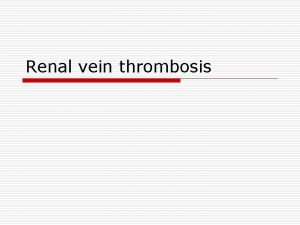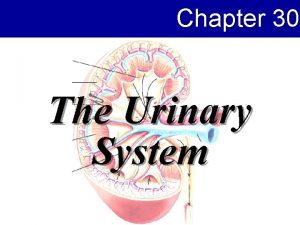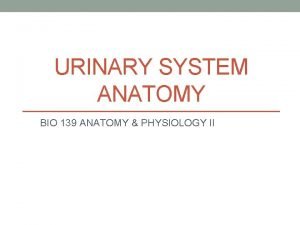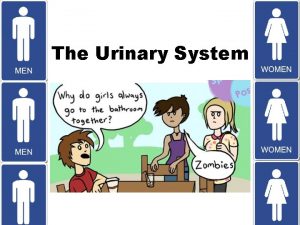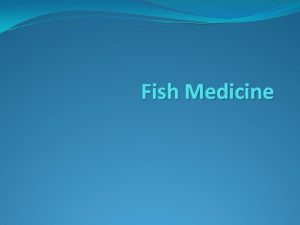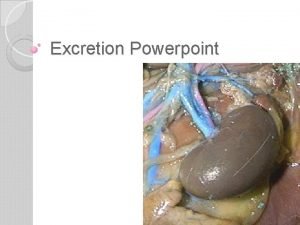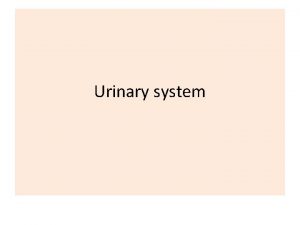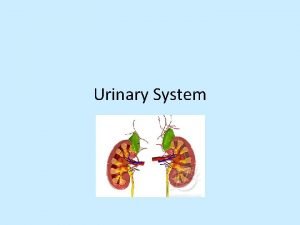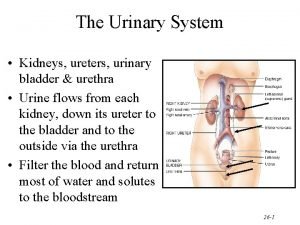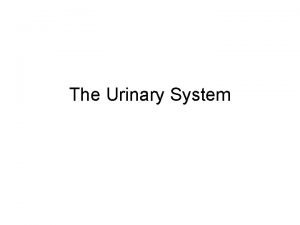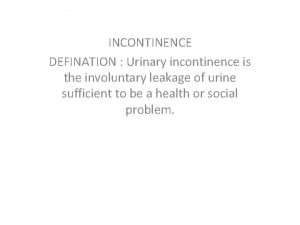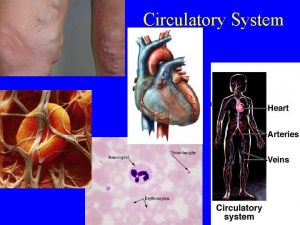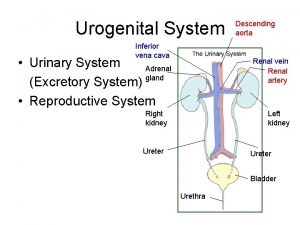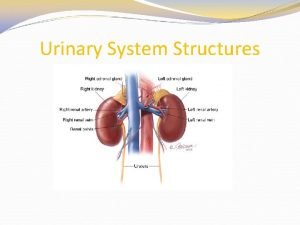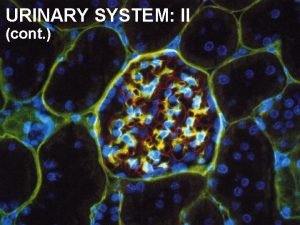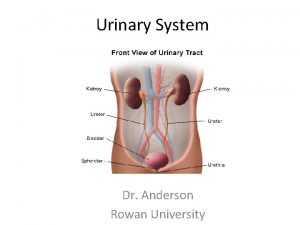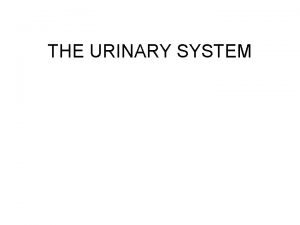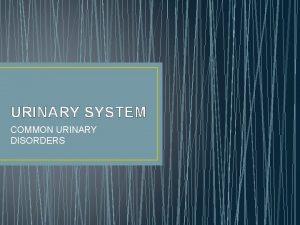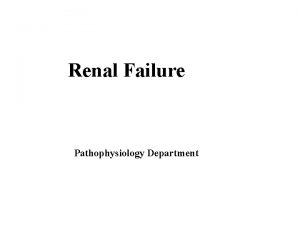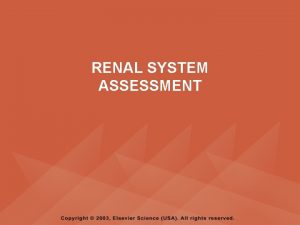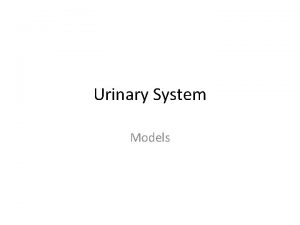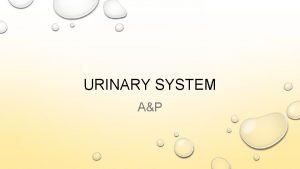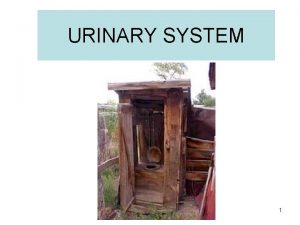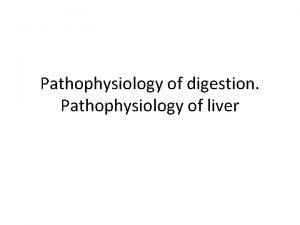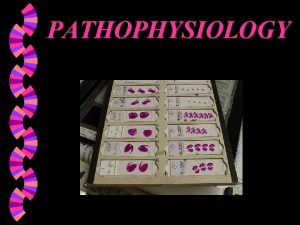Pathophysiology of Renal System Renal system urinary system































- Slides: 31

Pathophysiology of Renal System

Renal system (urinary system) Consists of the kidneys, ureters, urinary bladder, and urethra Functions of the kidney 1 - Excretion of metabolic wastes 2 - Regulation of mineral and water balance, p. H, … 3 - Release of renin that is important in ABP and blood volume regulation 4 - Release of erythropoietin hormone that stimulates RBCs formation

Kidney Nephron - Functional unit of the kidney, the structure that actually produces urine in the process of removing waste and excess substances from the blood. - It is tiny filtering structure in kidneys. - There about 1, 000 nephrons in each kidney. - Each nephron is composed of two main structures: the glomerulus and renal (kidney) tubule. -

The Glomerulus is a tiny blood vessel or capillary filter blood and remove excess fluids The Tubule is a tiny tube where the wastes, extra fluid and other recyclable substances like sodium and potassium filtered out from the glomerulus pass through.

Diagram of Kidney Nephron Efferent arteriole Afferent arteriole Bowman’s capsule Distal convoluted tubule Collecting duct Proximal convoluted tubule Glomerulus Peritubular capillaries Vasa recta Decending limb of loop of Henle Ascending limb of loop of Henle Unit 1 - Objective 4

https: //www. youtube. com/watch? v=Z 2 Pug. QZFLR 0

Kidney Diagram Medulla Papilla Pyramid Cortex Nephron Calyx Renal Vein Renal Artery Pelvis Column Capsule Ureter

Pathophysiology of Renal System

Glomerulonephritis �Is inflammation of the glomeruli �Glomeruli remove excess fluid, electrolytes and waste from your bloodstream and pass them into your urine. �Also called glomerular disease, glomerulonephritis can be acute — a sudden attack of inflammation — or chronic — coming on gradually.

• Causes • Occurs 7 -10 days following an infection with group A streptococcus, • Viral infection • Autoimmune diseases, (occurs when the body’s immune system attacks the body itself).



Manifestations of glomerulonephritis 1 - Proteinuria: proteins in urine 2 - Hematuria: blood in urine 3 - Hypertension 4 - In chronic glomerulonephritis: renal insufficiency (decreased urine volume and fluid retention) and renal failure. 5 - Fluid retention (edema) with swelling evident in your face, hands, feet and abdomen

Treatment of glomerulonephritis 1 - Antibiotics : to overcome bacterial infection 2 -Immunosuppressive drugs: to overcome autoimmune destruction of the glomeruli 3 -Management of the resulting edema, mineral imbalance and hypertension

Urinary tract infection (UTI) �Is an infection in any part of the urinary system —kidneys, ureters, bladder and urethra. Most infections involve the lower urinary tract — the bladder and the urethra. e. g. Cystitis = inflammation of urinary bladder Pyelonephritis = inflammation of the kidney Urethritis = inflammation of the urethra �Occurs most frequently in females �Frequent UTI may indicate urinary tract obstruction

Symptoms of UTIs A burning feeling when you urinate A frequent or intense need to urinate, even though little comes out when you do Pain or pressure in your back or lower abdomen Cloudy, dark, bloody, bright pink or strange-smelling urine Pelvic pain Feeling tired Fever or chills

Risk factors Female anatomy. A woman has a shorter urethra than a man does, which shortens the distance that bacteria must travel to reach the bladder. Blockages in the urinary tract Catheter use A suppressed immune system Treatment: 1 -Appropriate antibiotics 2 -Surgical correction of obstruction if present

Renal calculi �Also called Kidney stones: are solid masses made of crystals �Kidney stones usually originate in kidneys, but can develop anywhere along your urinary tract �Form mainly in renal pelvis, but can form anywhere in the kidneys The causes of kidney stones vary according to the type of stone

Types of Kidney Stones The different types of kidney stones include: - Calcium salts (the most common e. g. calcium oxalate ) Uric acid (this type of stone develops when urine is too acidic. - Cystine -

Predisposing Factors: The greatest risk factor for kidney stones is making less than one liter of urine per day Family or personal history. Dehydration (urine becomes concentrated, allowing minerals to crystallize and stick together) Changes in urine p. H High-protein, salt, or glucose diet Gout Obstruction of urine flow Being obese.


�Manifestations: 1 -May be asymptomatic 2 - In case of obstruction: severe pain and decreased urine volume 3 - Hematuria, 4 - Fever and chills due to associated UTI 5 -GIT symptoms: nausea and vomiting from pain 4 - frequent need to urinate �Treatment: 1 -Preventive measures: increased fluid intake and reduced serum uric acid levels 2 -Surgical removal of the stones 3 -Lithotripsy: ultrasonic destruction of the stones

Renal failure �Means significant loss of renal functions to the point where less than 10 -20% of normal GFR remains �May be acute or chronic

Acute renal failure �When the kidneys suddenly become unable to filter waste products from blood. When the kidneys lose their filtering ability, dangerous levels of wastes may accumulate and blood's chemical makeup may get out of balance. �It’s common in people who are already in the hospital. People who are critically ill and need intensive care have the highest risk of developing acute kidney failure �It may be reversible.

• Causes: -Prerenal: caused by decreased blood flow to the kidney as in shock, hemorrhage and hypotension -Intrarenal: caused by renal diseases -Postrenal: caused by obstruction of urine flow by calculi, prostatic enlargement and tumors

Acute renal failure (cont) �Manifestations: 1 -Oliguria : decreased urine volume 2 -Elevated blood urea nitrogen (BUN) and serum creatinine 3 -Alteration of serum electrolytes 4 -Possible edema and fluid retention �Treatment: 1 - Prevention: by control of ABP 2 -Correction of fluid and electrolyte imbalance 3 -Dialysis

Chronic renal failure Also called chronic kidney failure, describes the gradual loss of kidney function � Causes: 1 - Chronic renal diseases 2 - Renal obstruction 3 - Toxins or drugs 4 - Diabetes 5 - Hypertension 6 - Autoimmune diseases

�Manifestations : is a multisystem disease: 1 - Body fluids: polyuria and acidosis 2 -Blood: anemia due to decreased erythropoietin production (hormone produced largely in the kidneys that influences the rate of production of red blood cells) 3 -CVS: hypertension and edema due to activation of renin-angiotensin system (increase blood pressure. ) 4 -GIT: anorexia and nausea due to accumulation of wastes 5 -CNS: uremic encephalopathy due to accumulation of ammonia 6 -Musculoskeletal: muscle and bone weakness due to loss of calcium and minerals

• Treatment: 1 -Management of fluids and electrolytes 2 -Restriction of protein intake to minimize waste products in your blood 3 -Erythropoietin to treat anemia 4 -Renal dialysis 5 -Renal transplantation


Thanks
 Res extra commercium
Res extra commercium Teoria do nefron intacto
Teoria do nefron intacto Renal vein thrombosis pathophysiology
Renal vein thrombosis pathophysiology Vasa recta vs peritubular capillaries
Vasa recta vs peritubular capillaries Lymphatic system
Lymphatic system Physiology of urine formation
Physiology of urine formation Figure 15-3 the urinary system
Figure 15-3 the urinary system Urethr/o medical terminology
Urethr/o medical terminology Interesting facts about the urinary system
Interesting facts about the urinary system Uterus pig
Uterus pig Chapter 30 the urinary system workbook answers
Chapter 30 the urinary system workbook answers Chapter 15 the urinary system figure 15-3
Chapter 15 the urinary system figure 15-3 Chapter 20 urinary/excretory system
Chapter 20 urinary/excretory system Urinary system model
Urinary system model Urinary system fun fact
Urinary system fun fact Fish urinary system
Fish urinary system Urinary system powerpoint
Urinary system powerpoint Parietal layer of bowman's capsule
Parietal layer of bowman's capsule Function of antidiuretic hormone
Function of antidiuretic hormone Urinary bladder
Urinary bladder Abnormal constituents of urine
Abnormal constituents of urine Aescending
Aescending Defination of urine
Defination of urine Urinary system label
Urinary system label External anatomy of a rat
External anatomy of a rat Rat urinary system
Rat urinary system Vena cava urinary system
Vena cava urinary system Figure 15-3 the urinary system
Figure 15-3 the urinary system Urinary system
Urinary system Bowmans capsule
Bowmans capsule Urinary system
Urinary system Urinary system
Urinary system


